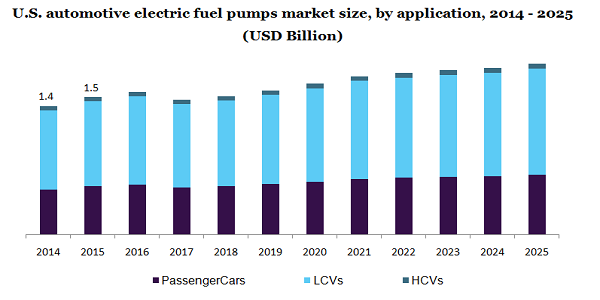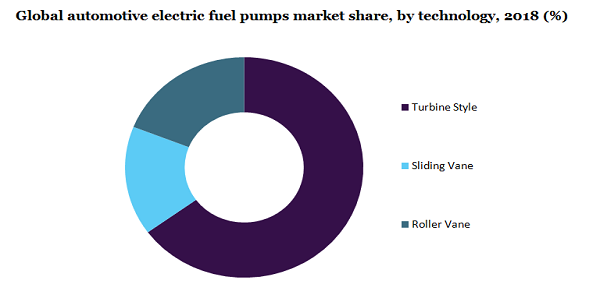- US: +1-408-610-2300
- Toll Free: +1-866-831-4085
- Become a Client
The global automotive electric fuel pumps market size was valued at USD 13.18 billion in 2018. It is projected to witness a CAGR of 5.0% CAGR over the forecasted years. The market is expected to attain 104.9 million units in terms of volume until 2025 with a 3.1% CAGR from 2019 to 2025. This can be attributed to the rising demand for passenger and commercial vehicles across developing countries like China and India.
The electric fuel pump is an integral part of every automobile and is used for injecting the fuel from the tank to the engine. These pumps have replaced the conventional pumps on account of an increase in fuel efficiency on their usage coupled with the implementation of advanced technologies in them for good performance of vehicles. These factors are projected to drive the demand for such pumps.

These pumps are largely being used in fuel injection engines on account of benefits like higher durability, fuel efficiency, reliability, and low noise generation capabilities. Moreover, its ability to push the exact quality of fuel by taking into account the engine’s operating conditions, optimal pressure maintenance, and reducing the chance of overheating is projected to drive market growth.
Such electric fuel pumps reduce the explosion risks arising due to low electrical load, gasoline vapor, reduced boiling risk, and boosted pump life. Also, rapid technological advances in the automobile sector for increasing fuel efficiency are projected to drive market growth in the upcoming years.
The global automotive electric fuel pumps market can be segmented into brushed DC and brushless DC based on the product type. In 2018, the segment of brushed DC held the largest share of around 60.0% across the global market. This share can be attributed to its rising adoption in passenger and heavy commercial vehicles for the prevention of abnormal wear due to spark discharges.
The demand for brushless DC motors is also increasing on account of several benefits like more torque and weight ratio, more electric conductive efficiency, good reliability, and product longevity. Thus, this segment is anticipated to register faster growth over the forecasted period, 2019 to 2025.
In 2018, the application segment of passenger cars held the largest share exceeding 75.0% across the global market. This can be associated with the rising demand and production of passenger cars across countries like China, Brazil, and India. Moreover, strict rules and regulations being imposed by statutory governing organizations for vehicle emissions like Euro 6 are further anticipated to fuel up the market growth for this segment.
The segment of HCVs (Heavy commercial vehicles) is also projected to gain traction over the forecasted period, 2019 to 2025. This can be attributed to the growth of the construction industry across developing countries coupled with rapid industrialization.
Based on technology, the global market can be segmented into turbine style, sliding vane, and roller vane. The segment of the turbine-style dominated the global market with a share of around 67.0% in 2018. It is also anticipated to witness a 5.1% CAGR from 2019 to 2025. This can be associated with its rising adoption across recently manufactured ICE vehicles.

Salient features like improved operational capabilities at a high speed of around 7000 rpm coupled with the low current drawing capacity are projected to drive the market growth. Also, benefits like pressure measurement, less noise emission, easy installation, and high performance are expected to boost the market growth of this segment.
In 2018, Asia Pacific held the largest share of around 57.0% across the global market. It is also anticipated to register the highest growth over the forecasted period, 2019 to 2025. This can be associated with the rising demand for heavy commercial vehicles and passenger cars across the millennial population in countries like China, India, and Korea.
Several key players like Hyundai, Toyota, Suzuki, and Honda are headquartered across the Asia Pacific. This is leading to the lowering of vehicle prices across this region on account of a reduction in transportation costs. Thus, the majority of the millennial population across this region is anticipated to adopt the usage of vehicles in the upcoming years.
The market for automotive electric fuel pumps is negatively affected on account of the ongoing COVID-19 crisis. Recession across the automobile sector coupled with a decrease in demand for passenger cars during the pandemic period, as they belong to the non-essential products category is expected to hinder the demand for automobiles, thereby reducing the consumption of such fuel pumps. China is one of the major suppliers of automobile parts like fuel pumps. However, as the supply chain across China has been affected on account of restrictions over cargo transport imposed by several countries, the market is witnessing challenging times in this period.
But, the rising preference for self-owned vehicles for traveling purposes instead of public transport during the post-pandemic period is projected to drive the demand for passenger vehicles. Moreover, rapid technological advances being carried out across automobile is expected to further fuel up the demand for automobile electric fuel pumps in the upcoming years.
The key players in the automotive electric fuel pumps market are Denso Corporation, Continental AG, Robert Bosch, General Motors Company, Delphi Automotive PLC, and Visteon Corporation. They are investing hugely in product innovation and development to widen their geographical reach and gain a competitive advantage.
They have also started implementing strategies like partnerships, mergers, and acquisitions over regional players to widen their geographical reach. For example, Pricol Limited had collaborated with Wenzhou Huirun Electrical Machinery Co Ltd. in 2018 for producing fuel pumps in India.
|
Attribute |
Details |
|
The base year for estimation |
2018 |
|
Actual estimates/Historical data |
2014 - 2017 |
|
Forecast period |
2019 - 2025 |
|
Market representation |
Volume in million units, revenue in USD million, and CAGR from 2019 to 2025 |
|
Regional Scope |
North America; Europe; Asia Pacific; Central & South America (CSA); MEA |
|
Country Scope |
U.S.; Germany; U.K.; China; India; Japan; Brazil |
|
Report coverage |
Revenue forecast, competitive landscape, growth factors, and trends |
|
15% free customization scope (equivalent to 5 analyst working days) |
If you need specific information, which is not currently within the scope of the report, we will provide it to you as a part of the customization |
This report forecasts revenue growth at the global, regional, and country levels and provides an analysis of the latest industry trends from 2014 to 2025 in each of the sub-segments. For this study, Million Insights has segmented the global automotive electric fuel pumps market based on technology, product, application, and region:
• Technology Outlook (Revenue, USD Million; Volume, Million Units, 2014 - 2025)
• Turbine Style
• Sliding Vane
• Roller Vane
• Product Outlook (Revenue, USD Million; Volume, Million Units, 2014 - 2025)
• Brushed DC
• Brushless DC
• Application Outlook (Revenue, USD Million; Volume, Million Units, 2014 - 2025)
• Passenger Cars
• LCVs
• HCVs
• Regional Outlook (Revenue, USD Million; Volume, Million Units, 2014 - 2025)
• North America
• U.S.
• Europe
• Germany
• U.K.
• The Asia Pacific
• China
• India
• Japan
• Central & South America
• Brazil
• Middle East & Africa (MEA)


Research Support Specialist, USA